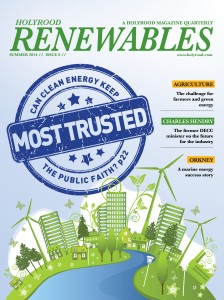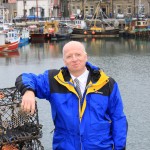Blog: Wave and tidal energy – why the wait?
 Ever wondered why it’s taking so long for marine renewables to develop to commercialisation? It’s a question that we are asked and that we see throughout the media regularly, however relative to other industries it really isn’t taking very long at all.
Ever wondered why it’s taking so long for marine renewables to develop to commercialisation? It’s a question that we are asked and that we see throughout the media regularly, however relative to other industries it really isn’t taking very long at all.
Our Managing Director, Neil Kermode, addresses this frequently asked question in Holyrood Renewables magazine this month. His article entitled ‘Wave and Tidal Energy – why the wait?’ is available to read below. If you do happen to pick up a copy of Holyrood Renewables, be sure to read the article on pages 19-21 as well, where Orkney is described as the ‘epicentre of marine energy’, with Richard Yemm (CEO and founder of Pelamis Wave Power) and Paul Verhoef (Head of Unit for New and Renewable Sources at the European Commission) looking at the great advancements that have taken place in marine renewables in Orkney, and how important it is to keep momentum going.
Is wave and tidal energy like tomorrow – the day that never comes?
EMEC, the European Marine Energy Centre in Orkney has been in place for over a decade, and in that time has become the world’s leading centre for testing wave and tidal machines in some of the most challenging seas in Europe.
Last year there were 11 devices being tested – more than anywhere else on the planet – and in the near future we will see some of the first pre-commercial tidal farms around our coasts. Yet more or less every week I am asked “why is it taking so long?”
My first response is that it is not. Generating electricity from the sea is an enormous challenge, and we have only been tackling it with serious intent for around ten years. But the weight of expectation and our impatience to see results has blinded many of us to the length of time genuine innovation can take.
Harnessing the power of the waves and tides is one of the world’s last renewable energy challenges, and is an idea that has occupied minds for millennia, but only now are the economic and environmental imperatives in place to make it actually happen.
In Orkney we are seeing real evidence of climate change, with crashing sea-bird populations leaving the cliffs practically deserted. We are facing serious electricity grid related problems caused by past decisions which were driven by fossil fuel based thinking. But at the same time we are seeing ways to achieve climate change targets, the economic opportunities that presents, and the public support for tackling this. Yet all this is happening whilst focus has shifted from security of supply and climate change to short term concerns about price. It is a complex picture.
It was the OPEC oil price shock of the early 1970s that first kick-started the UK Government’s marine energy research programme, but by the time we struck North Sea oil, that good intent had waned and all of our world-leading research was put on ice. It has only been in this century, with the growing reality of climate change, that we have begun again to look at ocean energy in earnest.
Ten years is not a long time, and if we look back over history we can see that innovative new technologies can take many decades, or centuries even, to mature.
Today we take it for granted we can take a seat in modern jet and travel safely and with comfort more than 8000 miles around the globe. But the first successful prototype, the Wright brothers’ Flyer, first took to the air more than a century ago. And before this there were decades of failures, many catastrophic, to reach that point. Wind the clock back to 1842 and the most advanced concept was a propeller powered aerial steam carriage – clearly an idea ahead of its time. It was only by 1903 that engines were light enough to make powered flight possible, and it was only by the 1950s after two world wars and fifty years of furious innovation that mass air travel became feasible.
The point I am making is the first prototype is, in many cases, the start of the journey. Technology development is a process, and the first prototypes are only a beginning. That is where we are with ocean energy today. We know that wave and tidal machines work and produce electricity – the challenge now is to do so reliably and at lower cost.
The Diesel engine is a good example. It was (of course) a Briton, Akroyd Stuart, who filed the first patent in 1890, but it was the German Rudolf Diesel who in 1897 patented the high compression technology we recognise today. His new engines boasted 75 percent efficiency compared to 10 per cent for steam and by the end of the century his technology was in wide use, and Mr Diesel was a millionaire.
It was a technology whose time had come – there was already a market for engines, the global economy was dependent on steam – and with a Diesel engine any factory owner or railwayman could make a better return.
But the Diesel engine is a technology which has taken a century to mature. Even as late as the 1970s the clunky Diesel Lada was shorthand for eastern bloc low-tech, but by 2006 the Audi R10 TDI (fuelled by a $15 million annual research budget) had won Le Mans. Today the turbo diesel is the average road warrior’s engine of choice.
Market forces have been enough to propel continual innovation in the modern aeroplane and the Diesel engine, but for some technologies no market exists, or the scale of the challenge is so vast, that governments must intervene.
It was in May 1961 that John F Kennedy set the goal of landing a man on the moon and bringing him back safely to earth by the end of the decade. The Apollo programme of course succeeded, and led to multiple innovations and unexpected discoveries; but there were also countless failures and tragedies too. That is the route map to innovation – as Thomas Edison said: “I have not failed. I’ve just found 10,000 ways that won’t work.”
There was no way private capital could have enabled the moon landings. And it only happened so fast because so much resource was thrown at it. At its height, the Apollo programme employed more than 400,000 people and consumed over four per cent of the entire federal budget, with an average spend of $15 billion per annum in today’s money.
Of course many would counter there is no way we could or should dedicate £multi-billion budgets to new energy research – but the simple fact is we already do. The International Nuclear Fusion Project (Iter) was launched in 2013, and brings together 34 nations with a budget of £13 billion, with the goal of producing a prototype in 20 years. The US fusion project began in 1953 and has so far spent $22.4 billion (or $393 million a year in today’s money). In short, this is a hugely well-funded 80 year technology development programme.
I am not knocking nuclear. But imagine how fast our wave and tidal technologies could advance if they were dedicated even a tiny fraction of that kind of expenditure? Even in the UK our own Department of Energy and Climate Change dedicates over £2 billion a year to the nuclear industry.
Our wave and tidal technologies have made tremendous strides and have got to the point where we can see the path ahead. The challenge, as many have said, is financial as much as technical and as the examples above show – technology development does not happen overnight.
It requires time – and above all vision, funding and a steady hand. A decade is not long in the grand sweep of history, and the UK has a global lead in wave and tidal technologies. With the right kind of long-term support, imagine where we could be a decade from now?
Here in Orkney we see daily how renewables fits into the landscape, generates jobs, creates wealth, is widely supported and enables a sustainable future for us all. This stuff works!
If this is not the moment to push harder then when will be?
And if not us then who?
Neil Kermode, managing director of the European Marine Energy Centre






